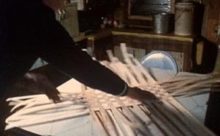The Dilemma of Primitivism in a Tribal Film Project
By way of illustrating the representational dilemma faced by contemporary American Indian communities, I offer here an example from my own work with various tribal film projects concerning indigenous cultural survival and native rights–an ethnographic documentary sponsored by the Aroostook Band of Micmacs. When I began working for this landless tribal group in northern Maine in 1981, the community was depressed and depressing. Crushed by chronic poverty and victimized by racism, many families resided in shacks and suffered from poor health. Few had more than an eighth-grade education and most depended on seasonal labor and crafts for their meager income. Unlike the region's other three Indian groups, the Aroostook Mi'kmaq were not federally recognized and did not share in the $81.5 million land claims settlement which had extinguished their aboriginal title to lands in Maine.
In 1983, I suggested making a documentary, and the community agreed. We marked out three objectives: to document and preserve their traditional arts and crafts, in particular basketry; to strengthen their own cultural identity through collaboration on a collective project of self-representation; to inform the public of their existence and (indirectly) their legitimate struggle for native rights in Maine. This tribal media project triggered the challenge of their visual self-representation. Seeking political support, the Mi’kmaq were wary of provoking or offending white society by sharply exposing the discrimination and injustices inflicted on them. They hoped to debunk negative stereotypes and avoid the romantic exoticism of Hollywood stereotypes, while presenting themselves in a positive light and showing how they actually made their living.
At the time, less than a dozen families still depended primarily on basketry, but for generations it had been a common livelihood for most Mi’kmaqs because it gave them some autonomy in a white-dominated world. Accordingly, we decided to focus on basketry as emblematic of Mi'kmaq identity and survival. Trained in 16mm film-making, I served as the project director (and invited film-maker Karen Carter as co-producer). Working with a small camera crew, we used an Arriflex 16BL camera and a Nagra 4.2 audio recorder. In addition to documenting Mi'kmaqs making baskets, we filmed them working on white-owned potato farms and shot footage of large modern harvesting machines that were replacing hand-pickers. (I only recently recognized the latter as a hint of the familiar theme of primitivism.) Titled Our Lives in Our Hands, the film premiered at the 1985 Native American Film Festival in New York City, where it was introduced by Donald Sanipass, a respected community leader and one of the featured basketmakers. A few weeks later, it debuted in Presque Isle and had several airings on Maine Public Television. Many other public screenings followed. To rally political support for their native rights cause, tribal spokespeople (including myself) almost always accompanied the film at these showings. The effort paid off: In 1991 the tribe gained formal recognition of its federal status, as well as a $900,000 land acquisition fund to purchase a small reservation. Although the political message in this documentary remains subliminal, the film was instrumental in reshaping the political landscape in northern Maine and helped the region's Mi'kmaqs to dramatically improve their own place in it. Our Lives in Our Hands succeeded as political advocacy film without being framed in primitivist terms. As a visual performative, it could only do so because of the larger road show in which Mi'kmaq cultural activists made direct personal appeals for political and moral support (Prins 1994, 1996, 1997b; Turnbaugh and Turnbaugh 1988).
